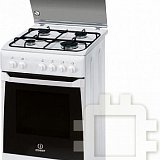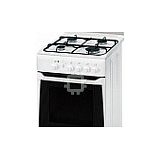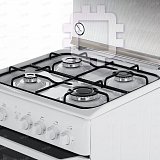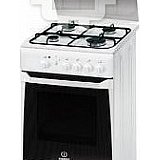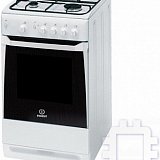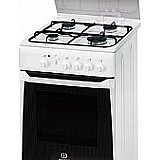Indesit KN 1 G27: инструкция
Характеристики, спецификации
Инструкция к Плите газовой Indesit KN 1 G27

RS
GB
KJ1 G 207 S /RU
K 1 G 207 S /RU
K 1 G 2007 S /RU
KN1G27/RU
KNJ1G217/RU
KNJ1G27/RU

!
RS
!
!
!
!
!
!
A
!
2

RS
HOOD
Min. mm.
600
mm.
420
420
mm. with hood
mm. without hood
650
700
Min.
Min. mm.
min.
min.
!
!
!
!
!

RS
4
A
V
!
!
!
!
!

Изделие: Комбинированная плита
RS
Торговая марка:
Торговый знак изготовителя:
KJ1 G 207 S /RU
K 1 G 207 S /RU
K 1 G 2007 S /RU
Модель:
KN1G27/RU
KNJ1G217/RU
KNJ1G27/RU
Изготовитель: Indesit Company
Ст
р
ан
а
-изготовитель: Польша
Габаритные ра зм ер ы духового
34x39x38 см / 50 л
шкафа / Объем:
Номинальное значение
напряжения электропитания или
220-240 V ~
диапазон напряжения
Условное обозн ачение рода
электрического тока или
50/60Hz
номинальная час тота переменного
тока
Класс зашиты от поражения
Класс защиты I
электрическим током
Класс эне
р
гопот
р
ебления
ТАБЛИЧКА С ЭЛЕКТРИЧЕСКИМИ
ДАННЫМИ
Директива ЕС: Директива ЕС: 2006/95/EC от
12/12/06 (Низкое напряжение) с
В случае необходимости
последующими изменениями – 2004/108/ЕC
получения информации по
от 15/12/04 (Электромагнитная
сертификатам с оответств ия или
совместимость) с последующими
получения копий сертификатов
изменениями – 2009/142/ЕC от 30/11/09 (Газ) -
соответствия на данную технику,
90/68/СЕЕ от 22/07/93 с последующими
Вы можете отправить запрос по
изменениями – 2002/96/ЕС.
электронному адресу
1275/2008 (Stand-by/ Off mode)
cert.rus
@
indesit.com.
Дату производства данной техник и
- 1-ая цифра в S/N соответствует последней
можно получить из серийного
цифре года,
номера, расположенного под
- 2-ая и 3-я цифры в S/N - порядковому
штрих-кодом (S/N XXXXXXXXX *
номеру месяца года,
XXXXXXXXXXX), следующим
- 4-ая и 5-ая цифры в S/N - числу
образом:
определенного месяца и года.
Indesit Company S.p.A.
Производитель:
Виале А. Мерлони 47, 60044, Фабриано (АН),
Италия
Импо
р
те
р
: ООО "Индези т РУС"
до 01.01.2011: Россия, 129223, Москва,
С вопросами (в России)
Проспект Мира, ВВЦ, пав. 46
обращаться по адресу:
с 01.01.2011: Россия, 127018, Москва, ул.
Двинцев, дом 12, корп. 1

RS
286
181
95
183
S
S
A
R
KJ1 G 207 S /RU
K 1 G 207 S /RU
K 1 G 2007 S /RU
KN1G27/RU
KNJ1G217/RU
KNJ1G27/RU
6

RS
*

RS
!
!
!
!
!
!
8
F
X
C

RS
!
!
A
S
!
*

RS
Продукты Вес
Уровень Время нагревания
Рекомендуемая
Продолжит-ть
(кг)
(мин.)
температура (°C)
приготовления
(минуты)
Макаронные изделия
Лазанья
2.5
3
10
210
60-75
Каннеллони
2.5
3
10
200
40-50
Макаронная запеканка
2.5
3
10
200
40-50
Мясо
Телятина
1.7
3
10
200
85-90
Курица
1.5
3
10
220
90-100
Утка
1.8
3
10
200
100-110
Кролик
2
3
10
200
70-80
Свинина
2.1
3
10
200
70-80
Баранина
1.8
3
10
200
90-95
Рыба
Скумбрия
1.1
3
10
180-200
35-40
Камбала
1.5
3
10
180-200
40-50
Форель в фольге
1
3
10
180-200
40-45
Пицца
По-неаполитански 1 3 15 220 15-20
Выпечка
Печенье
0.5
3
15
180
30-35
Торт с вареньем
1.1
3
15
180
30-35
Несладкие торты
1
3
15
180
45-50
Выпечка из дрожжевого теста
1
3
15
180
35-40
Приготовление на гриле
Телячьи отбивные
1
4
5
-
15-20
Отбивные
1.5
4
5
-
20
Гамбургер
1
3
5
-
7
Скумбрия
1
4
5
-
15-20
Горячие бутерброды
4 шт.
4
5
-
5
Приготовление на вертеле в режиме
гриль
Телятина на вертеле
1
-
5
-
70-80
Курица на вертеле
2
-
5
-
70-80
Приготовление на вертеле в режиме
гриль с несколькими шампурами
Шашлык
1
-
5
-
40-45
Овощной шашлык
0.8
-
5
-
25-30
10

!
RS

RS
12

RS
!
!
!
!

RS
14

Operating Instructions
COOKER
GB
Contents
RS
GB
Installation, 16-20
,1
English,15
Positioning and levelling
Electrical connections
Gas connection
Adapting to different types of gas
Technical data
Table of burner and nozzle specifications
Description of the appliance, 21
Overall view
Control panel
Start-up and use, 22-24
Using the hob
Using the oven
Oven cooking advice table
KJ1 G 207 S /RU
Precautions and tips, 25-26
K 1 G 207 S /RU
General safety
K 1 G 2007 S /RU
Disposal
KN1G27/RU
Respecting and conserving the environment
KNJ1G217/RU
KNJ1G27/RU
Maintenance and care, 27
Switching the appliance off
Cleaning the appliance
Gas tap maintenance
Replacing the oven light bulb
Assistance

Installation
! Before operating your new appliance please read
Disposing of combustion fumes
GB
this instruction booklet carefully. It contains
important information concerning the safe installation
The disposal of combustion fumes should be
and operation of the appliance.
guaranteed using a hood connected to a safe and
efficient natural suction chimney, or using an electric
! Please keep these operating instructions for future
fan that begins to operate automatically every time
reference. Make sure that the instructions are kept
the appliance is switched on (
see figure
).
with the appliance if it is sold, given away or moved.
! The appliance must be installed by a qualified
professional according to the instructions provided.
! Any necessary adjustment or maintenance must be
performed after the cooker has been disconnected
from the electricity supply.
Room ventilation
Fumes channelled
Fumes channelled through
straight outside
a chimney or branched
The appliance may only be installed in permanently-
flue system reserved for
ventilated rooms, according to current national
cooking appliances)
legislation. The room in which the appliance is
! The liquefied petroleum gases are heavier than air
installed must be ventilated adequately so as to
and collect by the floor, therefore all rooms
provide as much air as is needed by the normal gas
containing LPG cylinders must have openings
combustion process (the flow of air must not be
leading outside so that any leaked gas can escape
3
lower than 2 m
/h per kW of installed power).
easily.
The air inlets, protected by grilles, should have a
LPG cylinders, therefore, whether partially or
2
duct with an inner cross section of at least 100 cm
completely full, must not be installed or stored in
and should be positioned so that they are not liable
rooms or storage areas that are below ground level
to even partial obstruction (
see figure A
).
(cellars, etc.). Only the
These inlets should be enlarged by 100% - with a
cylinder being used should be stored in the room;
2
minimum of 200 cm
- whenever the surface of the
this should also be kept well away from sources
hob is not equipped with a flame failure safety
of heat (ovens, chimneys, stoves) that may cause
device. When the flow of air is provided in an
the temperature of the cylinder to rise above 50°C.
indirect manner from adjacent rooms (
see figure B
),
provided that these are not communal parts of a
Positioning and levelling
building, areas with increased fire hazards or
bedrooms, the inlets should be fitted with a
! It is possible to install the appliance alongside
ventilation duct leading outside as described above.
cupboards whose height does not exceed that of the
Adjacent room Room requiring
hob surface.
ventilation
AB
! Make sure that the wall in contact with the back of
the appliance is made from a non-flammable, heat-
resistant material (T 90°C).
To install the appliance correctly:
A
• Place it in the kitchen, dining room or the bed-sit
(not in the bathroom).
Ventilation opening for
Increase in the gap between
• If the top of the hob is higher than the cupboards,
comburent air
the door and the flooring
the appliance must be installed at least 200 mm
away from them.
! After prolonged use of the appliance, it is
• If the cooker is installed underneath a wall cabinet,
advisable to open a window or increase the speed of
there must be a minimum distance of 420 mm
any fans used.
between this cabinet and the top of the hob.
This distance should be increased to 700 mm if
the wall cabinets are flammable (
see figure
).
16

• Do not position
GB
blinds behind the
cooker or less than 200
mm away from its
sides.
• Any hoods must be
installed according to
the instructions listed in
the relevant operating
manual.
Levelling
If it is necessary to level the
appliance, screw the
adjustable feet into the places
provided on each corner of the
base of the cooker (
see
figure
).
The legs* fit into the slots on
the underside of the base of
the cooker.
Electrical connection
Install a standardised plug corresponding to the
load indicated on the appliance data plate (
see
Technical data table
).
The appliance must be directly connected to the mains
using an omnipolar circuit-breaker with a minimum
contact opening of 3 mm installed between the
appliance and the mains. The circuit-breaker must be
suitable for the charge indicated and must comply with
NFC 15-100 regulations (the earthing wire must not be
interrupted by the circuit-breaker). The supply cable
must be positioned so that it does not come into
contact with temperatures higher than 50°C at any point.
Before connecting the appliance to the power
supply, make sure that:
• The appliance is earthed and the plug is compliant
with the law.
• The socket can withstand the maximum power of
the appliance, which is indicated by the data plate.
• The voltage is in the range between the values
indicated on the data plate.
• The socket is compatible with the plug of the
appliance. If the socket is incompatible with the
plug, ask an authorised technician to replace it.
Do not use extension cords or multiple sockets.
17
HOOD
Min. mm.
600
mm.
420
420
mm. with hood
mm. without hood
650
700
Min.
Min. mm.
min.
min.
! Once the appliance has been installed, the power
supply cable and the electrical socket must be
easily accessible.
! The cable must not be bent or compressed.
! The cable must be checked regularly and replaced
by authorised technicians only.
! The manufacturer declines any liability should
these safety measures not be observed.
Gas connection
Connection to the gas network or to the gas cylinder
may be carried out using a flexible rubber or steel
hose, in accordance with current national legislation
and after making sure that the appliance is suited to
the type of gas with which it will be supplied (see the
rating sticker on the cover: if this is not the case
see
below
). When using liquid gas from a cylinder, install a
pressure regulator which complies with current national
regulations. To make connection easier, the gas
supply may be turned sideways*: reverse the position
of the hose holder with that of the cap and replace the
gasket that is supplied with the appliance.
! Check that the pressure of the gas supply is
consistent with the values indicated in the Table of
burner and nozzle specifications (
see below
). This
will ensure the safe operation and durability of your
appliance while maintaining efficient energy
consumption.
Gas connection using a flexible rubber hose
Make sure that the hose complies with current
national legislation. The internal diameter of the hose
must measure: 8 mm for liquid gas supply; 13 mm
for methane gas supply.
Once the connection has been performed, make
sure that the hose:
• Does not come into contact with any parts that
reach temperatures of over 50°C.
• Is not subject to any pulling or twisting forces and
that it is not kinked or bent.
• Does not come into contact with blades, sharp
corners or moving parts and that it is not
compressed.
• Is easy to inspect along its whole length so that
its condition may be checked.
• Is shorter than 1500 mm.
• Fits firmly into place at both ends, where it will be
fixed using clamps that comply with current
* Only available in certain models
regulations.

GB
18
A
V
! If one or more of these conditions is not fulfilled or
3. While the burner is alight, quickly change the position
if the cooker must be installed according to the
of the knob from minimum to maximum and vice versa
conditions listed for class 2 - subclass 1 appliances
several times, checking that the flame is not
(installed between two cupboards), the flexible steel
extinguished.
hose must be used instead (
see below
).
! The hob burners do not require primary air adjustment.
Connecting a flexible jointless stainless steel pipe
to a threaded attachment
Adapting the oven
Make sure that the hose and gaskets comply with
Replacing the oven burner nozzle:
current national legislation.
1. Remove the oven compartment.
To begin using the hose, remove the hose holder on the
2. Slide out the protection
appliance (the gas supply inlet on the appliance is a
panel A
cylindrical threaded 1/2 gas male attachment).
(
see diagram
).
! Perform the connection in such a way that the hose
length does not exceed a maximum of 2 metres,
making sure that the hose is not compressed and
does not come into contact with moving parts.
3. Remove the oven burner
Checking the connection for leaks
after unscrewing the screws V
(
see figure
).
When the installation process is complete, check
The whole operation will be
the hose fittings for leaks using a soapy solution.
made easier if the oven door
Never use a flame.
is removed.
Adapting to different types of gas
4. Unscrew the nozzle using a
It is possible to adapt the appliance to a type of gas
special nozzle socket spanner
other than the default type (this is indicated on the
(
see figure
) or with a 7 mm
rating label on the cover).
socket spanner, and replace it
with a new nozzle that is
Adapting the hob
suited to the new type of gas
(
see Burner and nozzle
Replacing the nozzles for the hob burners:
specifications table
).
1. Remove the hob grids and slide the burners off
their seats.
Adjusting the gas oven burner’s minimum setting:
2. Unscrew the nozzles using a
1. Light the burner (
see Start-up and Use
).
7 mm socket spanner (
see
2. Turn the knob to the minimum position (MIN) after
figure
), and replace them with
it has been in the maximum position (MAX) for
nozzles suited to the new type
approximately 10 minutes.
of gas(
see Burner and nozzle
3. Remove the knob.
specifications table
).
4. Tighten or loosen the adjustment screws on the
3. Replace all the components
outside of the thermostat pin (
see figure
) until the
by following the above
flame is small but steady.
instructions in reverse.
! If the appliance is connected to liquid gas, the
adjustment screw must be fastened as tightly as
Adjusting the hob burners’ minimum setting:
possible.
1. Turn the tap to the minimum position.
2. Remove the knob and adjust the regulatory
screw, which is positioned inside or next to the tap
pin, until the flame is small but steady.
! If the appliance is connected to a liquid gas
supply, the regulatory screw must be fastened as
tightly as possible.

5. Turn the knob from the MAX position to the MIN
TECHNICAL DATA
GB
position quickly or open and shut the oven door,
Oven dimensions
34x39x 38 cm
making sure that the burner is not extinguished.
(HxWxD)
Volume
50 l
Useful
width 42 cm
measurements
depth 44 cm
relating to the oven
height 17 cm
compartment
Power supply voltage
see data plate
and frequency
may be adapted for use with any
type of gas shown on the data
plate, which is located inside the
Burners
flap or, after the oven
compartment has been opened,
on the left-hand wall inside the
oven.
EC Directives: 2006/95/EC dated
12/12/06 (Low Voltage) and
subsequent amendments -
2004/108/EC dated 15/12/04
(Electromagnetic Compatibility)
and subsequent amendments -
90/396/EEC dated 29/06/90 (Gas)
and subsequent amendments -
93/68/EEC dated 22/07/93 and
subsequent amendments -
2002/96/EC.
1275/2008 (Stand-by/ Off mode)
19

GB
Table of burner and nozzle specifications
Table 1 Liquid Gas Natural Gas
Burner Diameter
Thermal Power
By-Pass
Nozzle
Flow*
Nozzle
Flow*
Nozzle
Flow*
(mm)
kW (p.c.s.*)
1/100
1/100
g/h
1/100
l/h
1/100
l/h
Nominal Reduced (mm) (mm) *** ** (mm) (mm)
Fast
100 3.00 0.7 41 86 218 214 116 286 143 286
(Large)(R)
Semi Fast
75 1.90 0.4 30 70 138 136 106 181 118 181
(Medium)(S)
Auxiliary
55 1.00 0.4 30 50 73 71 79 95 80 95
(Small)(A)
Oven - 2.00 1.0 54 68 145 143 107 190 114 183
Nominal (mbar)
28-30
37
20
13
Supply
Minimum (mbar)
20
25
17
6,5
Pressures
Maximum (mbar)
35
45
25
18
* At 15°C and 1013 mbar- dry gas
** Propane P.C.S. = 50,37 MJ/Kg
*** Butane P.C.S. = 49,47 MJ/Kg
3
S
S
Natural P.C.S. = 37,78 MJ/m
A
R
KJ1 G 207 S /RU
K 1 G 207 S /RU
K 1 G 2007 S /RU
KN1G27/RU
KNJ1G217RU
KNJ1G27/RU
20

Description of the
appliance
Overall view
GB
Control panel
TIMER
knob*
GAS BURNER
OVEN
Hob BURNER
ignition button*
control knob
control knobs
TIMER
knob*
GAS BURNER
OVEN
Hob BURNER
ignition button*
control knob
control knobs
* Only available in certain models.
21

Start-up and use
Using the hob
Practical advice on using the burners
GB
Lighting the burners
For the burners to work in the most efficient way
possible and to save on the amount of gas
For each BURNER knob there is a complete ring
consumed, it is recommended that only pans that
showing the strength of the flame for the relevant
have a lid and a flat base are used. They should also
burner.
be suited to the size of the burner.
To light one of the burners on the hob:
1. Bring a flame or gas lighter close to the burner.
2. Press the BURNER knob and turn it in an
anticlockwise direction so that it is pointing to the
maximum flame setting .
3. Adjust the intensity of the flame to the desired
level by turning the BURNER knob in an
anticlockwise direction. This may be the minimum
To identify the type of burner, please refer to the
setting , the maximum setting or any position
diagrams contained in the “Burner and nozzle
in between the two.
specifications”.
If the appliance is fitted with
Using the oven
an electronic lighting
device* (
C
), press the
! The first time you use your appliance, heat the
ignition button, marked with
empty oven with its door closed at its maximum
the symbol
, then hold
temperature for at least half an hour. Ensure that the
the BURNER knob down
room is well ventilated before switching the oven off
and turn it in an
and opening the oven door. The appliance may emit
anticlockwise direction, towards the maximum flame
a slightly unpleasant odour caused by protective
setting, until the burner is lit.
substances used during the manufacturing process
Several models are equipped with an ignition device
burning away.
which is built into the knob; in this case the
electronic ignition device* is present (
see figure
) but
! Before operating the product, remove all plastic
the ignition button is not. Simply press the BURNER
film from the sides of the appliance.
knob and turn it in an anticlockwise direction so that
it is pointing to the maximum flame setting, until the
! Never put objects directly on the bottom of the
burner is lit. The burner may be extinguished when
oven; this will avoid the enamel coating being
the knob is released. If this occurs, repeat the
damaged. Only use position 1 in the oven when
operation, holding the knob down for a longer period
cooking with the rotisserie spit.
of time.
Lighting the oven
! If the flame is accidentally extinguished, switch off
the burner and wait for at least 1 minute before
To light the oven burner, bring
attempting to relight it.
a flame or gas lighter close to
opening F (
see figure
) and
If the appliance is equipped with a flame failure
press the OVEN control knob
safety device (X), press and hold the BURNER knob
while turning it in an
for approximately 2-3 seconds to keep the flame
anticlockwise direction until it
alight and to activate the device.
reaches the MAX position.
To switch the burner off, turn the knob until it
If, after 15 seconds, the burner is still not alight,
reaches the stop position •.
release the knob, open the oven door and wait for at
least 1 minute before trying to light it again.
! The oven is fitted with a safety device and it is
therefore necessary to hold the OVEN control knob
down for approximately 6 seconds.
22
F
Burner ř Cookware diameter (cm)
Fast (R) 24 - 26
Semi Fast (S) 16 - 20
Auxiliary (A) 10 - 14
X
C

! If the flame is accidentally extinguished, switch off
Timer*
GB
the burner and wait for at least 1 minute before
To activate the Timer proceed as follows:
attempting to relight the oven.
1. Turn the TIMER knob in a clockwise direction
for almost one complete revolution to set the buzzer.
Adjusting the temperature
2. Turn the TIMER knob in an anticlockwise direction
to set the desired length of time.
To set the desired cooking temperature, turn the
OVEN control knob in an anticlockwise direction.
Temperatures are displayed on the control panel and
may vary between MIN (140°C) and MAX (250°C).
Once the set temperature has been reached, the
oven will keep it constant by using its thermostat.
Oven light
The light may be switched on at any moment by
pressing the OVEN LIGHT button.
Lower compartment
There is a compartment
underneath the oven
that may be used to
store oven accessories
or deep dishes. To open
the door pull it
downwards (
see
figure
).
! The internal surfaces of the compartment (where
present) may become hot.
! Do not place flammable materials in the lower oven
compartment.
In gas cooker models, there is
a sliding protection layer A
that shields the lower
compartment from the heat
generated by the burner (
see
figure
).
A
To remove the sliding
protection remove the screw S
(
see figure
). To replace it, lock
it in place with the screw S.
S
! Before using the oven make
sure that the sliding protection
is fixed correctly.
* Only available in certain models.
23

Oven cooking advice table
GB
Foods Weight (in
Rack
Preheating time (min) Recommended
Cooking time
kg)
position
Temperature (°C)
(minutes)
Pasta
Lasagne
2.5
3
10
210
60-75
Cannelloni
2.5
3
10
200
40-50
Gratin dishes
2.5
3
10
200
40-50
Meat
Veal
1.7
3
10
200
85-90
Chicken
1.5
3
10
220
90-100
Duck
1.8
3
10
200
100-110
Rabbit
2
3
10
200
70-80
Pork
2.1
3
10
200
70-80
Lamb
1.8
3
10
200
90-95
Fish
Mackerel
1.1
3
10
180-200
35-40
Dentex
1.5
3
10
180-200
40-50
Trout baked in foil
1
3
10
180-200
40-45
Pizza
Neapolitan-style 1 3 15 220 15-20
Pies
Biscuits
0.5
3
15
180
30-35
Tart
1.1
3
15
180
30-35
Savoury pies
1
3
15
180
45-50
Leavened cakes
1
3
15
180
35-40
Grilled foods
Veal steak
1
4
5
15-20
Cutlets
1.5
4
5
20
Hamburgers
1
3
5
7
Mackerel
1
4
5
15-20
Toast
4 pcs
4
5
5
Grillling using the rotisserie
Spit-roast veal
1
-
5
70-80
Spit-roast chicken
2
-
5
70-80
Grillling using the multi-spit rotisserie*
Meat kebabs
1
-
5
40-45
Vegetable kebabs
0.8
-
5
25-30
* Only available in certain models.
24

Precautions and tips
! This appliance has been designed and
• Always make sure the knobs are in the • position
GB
manufactured in compliance with international safety
and that the gas tap is closed when the appliance
standards.
is not in use.
The following warnings are provided for safety
• When unplugging the appliance, always pull the
reasons and must be read carefully.
plug from the mains socket; do not pull on the
cable.
• Never perform any cleaning or maintenance work
General safety
without having disconnected the appliance from
• These instructions are only valid for the
the electricity mains.
countries whose symbols appear in the manual
• If the appliance breaks down, under no
and on the serial number plate.
circumstances should you attempt to repair the
• The appliance was designed for domestic use
appliance yourself. Repairs carried out by
inside the home and is not intended for
inexperienced persons may cause injury or further
commercial or industrial use.
malfunctioning of the appliance. Contact
Assistance.
• The appliance must not be installed outdoors,
even in covered areas. It is extremely dangerous
• Do not rest heavy objects on the open oven door.
to leave the appliance exposed to rain and
storms.
• Do not let children play with the appliance.
• Do not touch the appliance with bare feet or with
• The appliance should not be operated by people
wet or damp hands and feet.
(including children) with reduced physical,
sensory or mental capacities, by inexperienced
• The appliance must be used by adults only for
individuals or by anyone who is not familiar with
the preparation of food, in accordance with the
the product. These individuals should, at the very
instructions outlined in this booklet. Any other
least, be supervised by someone who assumes
use of the appliance (e.g. for heating the room)
responsibility for their safety or receive
constitutes improper use and is dangerous.
preliminary instructions relating to the operation of
The manufacturer may not be held liable for
the appliance.
any damage resulting from improper, incorrect
and unreasonable use of the appliance.
Disposal
• The instruction booklet accompanies a class 1
(insulated) or class 2 - subclass 1 (recessed
• When disposing of packaging material: observe
between 2 cupboards) appliance.
local legislation so that the packaging may be
reused.
• Keep children away from the oven.
• The European Directive 2002/96/EC relating to
• Make sure that the power supply cables of other
Waste Electrical and Electronic Equipment
electrical appliances do not come into contact
(WEEE) states that household appliances should
with the hot parts of the oven.
not be disposed of using the normal solid urban
• The openings used for the ventilation and
waste cycle. Exhausted appliances should be
dispersion of heat must never be covered.
collected separately in order to optimise the cost
of re-using and recycling the materials inside the
• Do not close the glass hob cover (selected
machine, while preventing potential damage to
models only) when the burners are alight or when
the atmosphere and to public health. The
they are still hot.
crossed-out dustbin is marked on all products to
• Always use oven gloves when placing cookware
remind the owner of their obligations regarding
in the oven or when removing it.
separated waste collection.
Exhausted appliances may be collected by the
• Do not use flammable liquids (alcohol, petrol,
public waste collection service, taken to suitable
etc...) near the appliance while it is in use.
collection areas in the area or, if permitted by
• Do not place flammable material in the lower
current national legislation, they may be returned
storage compartment or in the oven itself. If the
to the dealers as part of an exchange deal for a
appliance is switched on accidentally, it could
new equivalent product.
catch fire.
25

All major manufacturers of household appliances
GB
participate in the creation and organisation of
systems for the collection and disposal of old and
disused appliances.
Respecting and conserving the
environment
• You can help to reduce the peak load of the
electricity supply network companies by using the
oven in the hours between late afternoon and the
early hours of the morning.
• Check the door seals regularly and wipe them
clean to ensure they are free of debris so that
they adhere properly to the door, thus avoiding
heat dispersion.
26

Care and maintenance
Switching the appliance off
The cover
GB
If the cooker is fitted with a
Disconnect your appliance from the electricity supply
glass cover, this cover
before carrying out any work on it.
should be cleaned using
lukewarm water. Do not use
Cleaning the appliance
abrasive products.
It is possible to remove the
! Do not use abrasive or corrosive detergents such as
cover in order to make
stain removers, anti-rust products, powder detergents or
cleaning the area behind
sponges with abrasive surfaces: these may scratch the
the hob easier. Open the
surface beyond repair.
cover fully and pull it
upwards (
see figure
).
! Never use steam cleaners or pressure cleaners on the
! Do not close the cover when the burners are alight or
appliance.
when they are still hot.
• It is usually sufficient simply to wash the hob using a
damp sponge and dry it with absorbent kitchen roll.
Inspecting the oven seals
• The stainless steel or enamel-coated external parts and
Check the door seals around the oven periodically. If the
the rubber seals may be cleaned using a sponge that
seals are damaged, please contact your nearest
has been soaked in lukewarm water and neutral soap.
Authorised After-sales Service Centre. We recommend
Use specialised products for the removal of stubborn
that the oven is not used until the seals have been
stains. After cleaning, rinse well and dry thoroughly. Do
replaced.
not use abrasive powders or corrosive substances.
Gas tap maintenance
• The hob grids, burner caps, flame spreader rings
and the hob burners can be removed
Over time, the taps may become jammed or difficult to
to make cleaning easier; wash them in hot water and
turn. If this occurs, the tap must be replaced.
non-abrasive detergent, making sure all burnt-on
residue is removed before drying them thoroughly.
!
This procedure must be performed by a qualified
This procedure must be performed by a qualifiedThis procedure must be performed by a qualified
This procedure must be performed by a qualifiedThis procedure must be performed by a qualified
• For hobs with electronic ignition, the terminal part of the
technician who has been authorised by thetechnician who has been authorised by the
technician who has been authorised by the
technician who has been authorised by thetechnician who has been authorised by the
electronic lighting devices should be cleaned
manufacturer.
manufacturer.manufacturer.
manufacturer.manufacturer.
frequently and the gas outlet holes should be checked
for blockages.
Replacing the oven light bulb
• The inside of the oven should ideally be cleaned after
1. After disconnecting the oven
each use, while it is still lukewarm. Use hot water and
from the electricity mains, remove
detergent, then rinse well and dry with a soft cloth. Do
the glass lid covering the lamp
not use abrasive products.
socket (
see figure
).
2. Remove the light bulb and
•
Clean the glass part of the oven door using a sponge
replace it with a similar one:
and a non-abrasive cleaning product, then dry
voltage 230 V, wattage 25 W, cap
thoroughly with a soft cloth. Do not use rough abrasive
E 14.
material or sharp metal scrapers as these could
3. Replace the lid and reconnect the oven to the electricity
scratch the surface and cause the glass to crack.
supply.
• The accessories can be washed like everyday
Assistance
crockery, and are even dishwasher safe.
Please have the following information handy:
• Stainless steel can be marked by hard water that has
• The appliance model (Mod.).
been left on the surface for a long time, or by
• The serial number (S/N).
aggressive detergents containing phosphorus. After
This information can be found on the data plate located on
cleaning, rinse well and dry thoroughly. Any remaining
the appliance and/or on the packaging.
drops of water should also be dried.
27

01/2011 - 195079714.02
XEROX FABRIANO
GB
28

